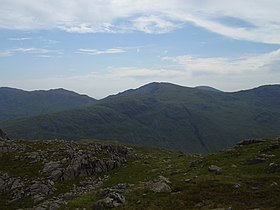Great Carrs
| Great Carrs | |
|---|---|

|
|
| Highest point | |
| Elevation | 788 m (2,585 ft) |
| Prominence | c. 20 m |
| Parent peak | Swirl How |
| Listing | Wainwright, Nuttall |
| Coordinates | 54°23′54″N 3°07′28″W / 54.39833°N 3.12438°WCoordinates: 54°23′54″N 3°07′28″W / 54.39833°N 3.12438°W |
| Geography | |
| Location | Cumbria, England |
| Parent range | Lake District, Southern Fells |
| OS grid | NY271009 |
| Topo map | OS Landranger 89,90, Explorer OL6 |
Great Carrs is a fell in the English Lake District. It stands above Wrynose Pass in the southern part of the District.
The Coniston (or Furness) Fells form the watershed between Coniston Water and the Duddon valley to the west. The range begins at Wrynose Pass and runs south for around 10 miles before petering out at Broughton in Furness on the Duddon Estuary. Alfred Wainwright in his influential Pictorial Guide to the Lakeland Fells took only the northern half of the range as Lakeland proper, consigning the lower fells to the south to a supplementary work The Outlying Fells of Lakeland. Great Carrs being the most northerly of the Coniston Fells therefore qualifies as one of the 214 Wainwrights. Later guidebook writers have chosen to include the whole range in their main volumes.
Swirl How stands at the geographical centre of the Coniston Fells and, according to some sources, may be the highest of the group. A long sickle shaped ridge extends from the summit of Swirl How, first north and then curving around to the east. Great Carrs is the high point of this ridge, which continues as Wet Side Edge, falling to the floor of Little Langdale. A western outlier branching off the main ridge between Great Carrs and Swirl How is Grey Friar.
Great Carrs, in common with many fells, has easy slopes to the west and crags to the east. These crags- falling directly from the summit- form the head of Greenburn. A steep sided, rather marshy valley, Greenburn is a part of the Little Langdale system, its waters joining the River Brathay at Little Langdale Tarn. Greenburn itself bears a tarn, or more correctly the remains of a reservoir. A natural waterbody was dammed in the early 18th century to provide water for the Greenburn Mine. The 250 yard long barrage has now been breached to leave a collection of pools and bogs. The mines in question, also known as New Coniston Mine, were worked for copper from 1845 until substantially abandoned in 1865, the shafts reaching a depth of 700 ft below ground. Greenburn is bounded to the north by the curve of Wet Side Edge and to the south by Wetherlam.
...
Wikipedia

